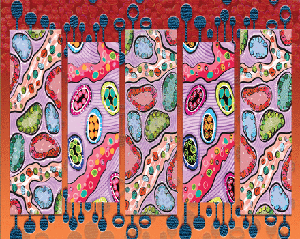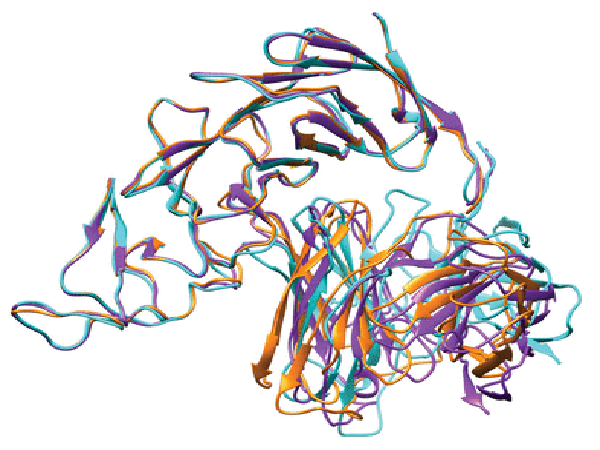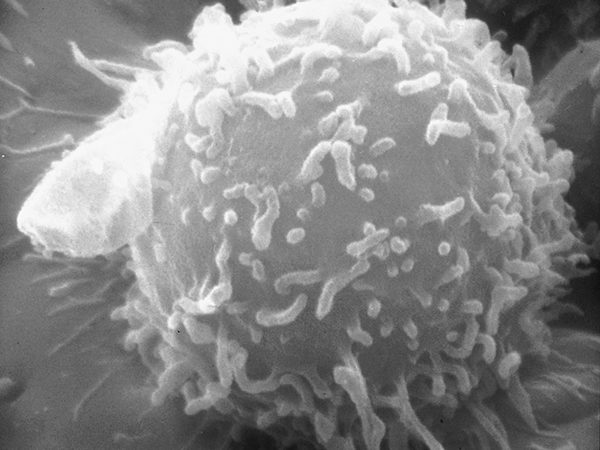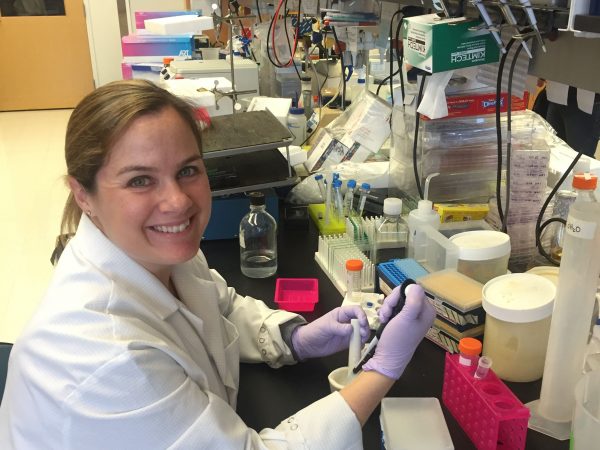Editors Share Highlights from AACR Journals
As we begin a new month, it is time to look back at some of the exciting research published in the nine AACR journals last month. For the month of May, the editors chose to highlight two phase I clinical trials, an analysis of cardiomyopathy in childhood cancer survivors of different races, and a meta-analysis examining mutations associated with blood cancer risk. As always, all of the highlighted articles are freely available for a limited time.
Journal: Clinical Cancer Research (May 1 issue)
The phosphoinositide 3-kinase (PI3K) signaling pathway is commonly activated in pediatric brain cancers. Everolimus inhibits mTOR, a key signaling protein within the PI3K pathway and is approved for the treatment of various cancers. In a prior clinical trial, concurrent treatment with ribociclib, an inhibitor of the CDK4/6 cell cycle protein, enhanced the efficacy of everolimus in adults. In this phase I clinical trial, researchers evaluated the safety and pharmokinetics of concurrent everolimus and ribociclib in pediatric patients with brain cancer. The trial enrolled 16 patients between the ages of 3 and 21 years. An additional six patients were enrolled in a surgical study to characterize the plasma and intratumor concentrations of ribociclib in patients undergoing surgical resection. Dose-limiting toxicities were observed in two patients, and the most common grade 3/4 treatment-related adverse events were lymphopenia, neutropenia, and leukopenia. The recommended phase II dose was 120 mg/m2 for 21 days for ribociclib, and 1.2 mg/m2 for 28 days for everolimus. Steady-state exposures of everolimus when administered with ribociclib were 2.5-fold higher than everolimus alone. The mean tumor-to-plasma ratio of ribociclib was 19.8. Together, the results indicate that everolimus and ribociclib were well tolerated and had pharmokinetic properties similar to those in adults. This article was highlighted in the May 1 issue.
In honor of May’s Brain Cancer Awareness Month, a recent blog post discussed additional advances in brain cancer research.
Journal: Blood Cancer Discovery
Large-scale Identification of Clonal Hematopoiesis and Mutations Recurrent in Blood Cancers

Clonal hematopoiesis of indeterminate potential (CHIP), which is the presence of mutations in hematopoiesis-associated genes in a person who does not have a hematologic malignancy, is associated with an increased risk of blood cancers. To understand which CHIP mutations have the greatest impact on cancer risk, the authors of this study completed a meta-analysis of 48 studies that had collected data on the hematologic mutations of adult and pediatric patients with acute leukemias, myeloproliferative neoplasms, and myelodysplastic syndromes. Among the identified mutations, 434 were significantly recurrent mutation hotspots, and 364 mutations could be confidently used to identify CHIP. The researchers then analyzed whole-exome sequencing data from 4,538 adults and children without cancer and found that approximately 1.8 percent of individuals had a CHIP mutation in one of the hotspot mutations identified in their meta-analysis. These findings may help improve CHIP detection and precancer monitoring in both adults and children. This study was featured on the cover of the May issue. A related commentary can be found here.
Journal: Cancer Epidemiology, Biomarkers & Prevention
Cancer Progress and Priorities: Breast Cancer
Breast cancer is the most commonly diagnosed cancer among women and the leading cause of cancer-related death among women worldwide. A comprehensive review published in the May issue of Cancer Epidemiology, Biomarkers & Prevention discussed the disease’s epidemiology, genetic and clinical heterogeneities, disparities, and risk factors, as well as current approaches to risk prediction, prevention, screening/early detection, and treatment. The authors noted several racial/ethnic disparities in breast cancer diagnoses and outcomes in the United States, including increasing incidence rates among Black women, but not among white women. In addition, the review explained that Black women are more likely to be diagnosed with more aggressive types of breast cancer and face higher mortality rates. While breast cancer incidence has decreased in recent years in the United States, Canada, and Europe due to advances in early detection and treatment, incidence has increased in Asia, Africa, and Latin America. To address these disparities, the authors propose further research into the risk factors underlying racial/ethnic disparities, development of improved risk prediction models, increased access to quality health care, and implementation of effective screening and cancer prevention approaches in high-risk populations.
Journal: Cancer Prevention Research
Excess body fat and sedentary lifestyles increase the risk of breast cancer development and death. Here, researchers examined how these factors impact the breast microenvironment. By analyzing breast tissue from 100 women who underwent therapeutic or preventive mastectomy, the authors found that inflammation was present in 56 women and was associated with increased age, elevated body-mass index (BMI), postmenopausal status, decreased exercise, hypertension, and dyslipidemia. Higher total body fat and trunk fat levels were associated with inflammation and increased levels of aromatase, which correlated with several markers of breast cancer development and progression. Higher levels of exercise were associated with lower levels of these breast cancer-related markers. Total fat levels were also associated with breast cancer-related markers in women with normal BMI. Together, the results indicate that elevated body fat and lack of exercise are associated with protumorigenic breast microenvironments in women with normal or high BMI. The authors suggest that BMI-agnostic interventions to reduce body fat may help reduce breast cancer risk.
Journal: Cancer Discovery
Endogenous retroelements from ancestral viral infections are typically suppressed through epigenetic mechanisms. However, epigenetic inhibitors commonly used for cancer therapy can reactivate expression of endogenous retroelements, leading to the accumulation of immunogenic nucleic acid and activation of interferon signaling. Prior research demonstrated that epigenetic inhibitors sensitized cancer cells to immune checkpoint inhibitors. Here, researchers hypothesized that interferon-independent mechanisms may also contribute to the cell death observed after epigenetic therapy. Using patient-derived cell lines treated with epigenetic inhibitors, the researchers observed that the binding of expressed retroelements by the RNA sensors RIG-I and MDA5 led to ATP hydrolysis and intracellular energy depletion. This triggered compensatory ATP production by mitochondrial oxidative phosphorylation, thereby reversing the cancer-mediated metabolic reprogramming known as the Warburg effect that favors anaerobic respiration. Hyperactivity of the metabolic enzyme succinate dehydrogenase led to oxidative stress, thereby triggering cancer cell death independently of interferon signaling. Since the proteins such as BCL2, among others, can inhibit cell death, the researchers tested the impact of adding BCL2 inhibitors or other proapoptotic agents to epigenetic therapy. They found that combined treatment with proapoptotic agents and epigenetic inhibitors led to synergistic killing of cancer cells in preclinical models of various hematologic cancers and solid tumors. The authors conclude that epigenetic therapy kills cancer cells through metabolic reprogramming and oxidative stress. This article was highlighted and featured on the cover of the May issue.
Journal: Cancer Research (May 1 issue)
Survivors of childhood cancer are at increased risk for cardiomyopathy due to exposure to cardiotoxic cancer therapies. The authors of this study compared cardiomyopathy incidence between 246 survivors of African ancestry and 1,645 survivors of European ancestry from the St. Jude Lifetime Cohort. Their analysis found that survivors of African descent had a 2.47-fold greater risk for cardiomyopathy as compared with survivors of European ancestry. Furthermore, a single nucleotide polymorphism (SNP) at locus 1p13.2 was significantly associated with ejection fraction, a marker of cardiomyopathy, in all survivors; however, the association was significantly stronger for survivors of African ancestry than those with European ancestry. Among survivors with the SNP and cardiomyopathy, the PHTF1 promoter region was found to be hypomethylated; survivors of African descent had increased levels of hypomethylation. Furthermore, PHTF1 gene expression was upregulated in cardiomyocytes from patients who had doxorubicin-induced cardiomyopathy. Together, these results provide mechanistic insight into cardiomyopathy and highlight racial disparities of therapy-related cardiomyopathy in survivors of childhood cancer. A related commentary can be found here.
Journal: Molecular Cancer Research
Angiosarcomas are rare and highly aggressive tumors of blood vessel-forming cells. While fusion oncogenes have been identified in a number of cancers, they have not been as well studied in angiosarcomas. Here, the authors analyzed RNA-sequencing data from 13 human and 76 canine hemangiosarcomas, which are common among dogs. In seven human tumors, the authors identified 10 novel protein-coding fusion genes, including TEX2-PECAM1 and ATP8A2-FLT1 fusions. Mutations in TP53, HRAS, and NRAS were also observed. In 11 of the 76 canine tumors, there were 15 novel protein-coding fusion genes, including MYO16-PTK2, GABRA3-FLT1, and AKT3-XPNEP1 fusions. In addition to these fusions, mutations in TP53, PIK3CA, PIK3R1, and NRAS were also observed in canine tumors. Tumors with fusion genes and TP53 mutations were enriched for angiogenic gene signatures. Tumors from both human and dogs contained molecular signatures associated with the activation of PI3K, AKT, and mTOR signaling. The authors propose that convergent activation of such signaling may regulate the highly conserved morphology and biological behaviors of tumors from human and dogs. This article was highlighted in the May issue.
Journal: Clinical Cancer Research (May 15 issue)
Graft-versus-host disease (GVHD) is an adverse event that may be associated with allogenic hematopoietic cell transplantation. Ruxolitinib is an inhibitor of the JAK2 protein that has been shown to suppress alloreactive T cells; however, it also limits the activity of beneficial immune cells, including immune-suppressing regulatory T cells. Pacritinib is an alternative JAK2 inhibitor that reduces T-cell alloreactivity without impacting regulatory T cells or other beneficial immune signaling. Here, researchers examined the efficacy of pacritinib in combination with the GVHD prophylaxis regimen of sirolimus and tacrolimus, which are both mTOR inhibitors. In mice, combined treatment with pacritinib, sirolimus, and tacrolimus reduced GVHD and increased the induction and potency of regulatory T cells. In a phase I clinical trial, the treatment regimen showed preliminary activity in preventing GVHD. The combination treatment suppressed alloreactive T cells without impacting regulatory T cells and antitumor effector cells. The minimum biologically active and safe dose was determined to be 100 mg twice a day. Pacritinib plus sirolimus and tacrolimus will be evaluated in an ongoing phase II GVHD prevention trial. This article was highlighted in the May issue.
Journal: Molecular Cancer Therapeutics

Robust Anti-tumor Activity and Low Cytokine Production by Novel Humanized Anti-CD19 CAR-T Cells
While anti-CD19 CAR-T cells have been effective in treating many blood cancers, they can also cause life-threatening toxicities, such as cytokine release syndrome. In this study, researchers developed a novel anti-CD19 CAR-T cell by humanizing the mouse scFv segment. They then tested the tolerability and immunogenicity of these humanized CAR-T cells in preclinical models. Compared to CAR-T cells with the mouse scFv, the humanized CAR-T cells had higher binding affinity to CD19 and similar proliferation and antitumor activity. In addition, humanized CAR-T cells led to lower cytokine production and IL-6 induction, suggesting that humanized CAR-T cells may be less likely to cause cytokine release syndrome. The authors conclude that their novel humanized CAR-T cells had a favorable balance of efficacy to toxicity. This article was highlighted and featured on the cover of the May issue.
Journal: Cancer Immunology Research
Immunotherapy and targeted therapy are both effective treatment options for patients with melanoma, a deadly form of skin cancer. However, the combination of these treatments is often toxic. In this study, investigators examined whether sequential treatment with these therapies would enhance responses. Using mouse models of BRAF- or NRAF-mutated melanomas, the authors found that anti-PD-1 immunotherapy followed by targeted therapy (either a ceritinib-trametinib regimen or dabrafenib-trametinib regimen) increased tumor infiltration by cells that mediate antitumor immunity, decreased infiltration by immunosuppressive cells, and increased expression of MHC class I and melanoma antigens. Durable responses to the treatment relied on the presence of CD8+ T cells. In addition, the sustained immune response observed after sequential therapy suppressed resistance pathways within melanoma cells. The results indicate that administering immunotherapy prior to targeted therapy may improve clinical responses in melanoma. This study was featured on the cover of the May issue.
In honor of last month’s Melanoma Awareness Month, a recent blog post discussed melanoma prevention and additional advances in melanoma research.
Journal: Cancer Research (May 15 issue)
The landscape of the heritable cancer genome
The heritability of cancer remains poorly understood. Prior studies have identified several SNPs that are associated with an increased risk for cancer, but their impact on inherited cancers remains unclear. In this study, the authors developed a tool, called Bayesian Gene HERitability Analysis (BAGHERA), to estimate the cancer heritability attributable to SNPs. Analysis of 38 cancers from the UK Biobank revealed that SNPs accounted for at least 10 percent of heritable risk in 14 cancers, including late-onset cancers. The authors also identified 1,146 genes that were involved in cellular transformation and significantly contributed to cancer heritability. Sixty genes harbored somatic driver mutations, and 27 genes were tumor suppressor genes. The authors suggest that these germline and somatic mutations could be used for cancer risk stratification, early detection, and cancer surveillance. A related commentary can be found here.



